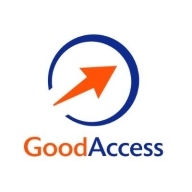

FortiGate Next Generation Firewall and GoodAccess compete in the cybersecurity domain, with FortiGate often seen as having the upper hand due to its robust security and extensive features.
Features: FortiGate is noted for its comprehensive feature set including SD-WAN, VPN integration, and robust security measures. Its seamless updates and extensive ecosystem offer a competitive edge. GoodAccess is praised for its dedicated IP, ease of firewall management, and security measures tailored for cloud integration. It supports intuitive VPN capabilities and rapid deployment, which is beneficial for its users.
Room for Improvement: FortiGate users point to a need for improved global support and enhanced GUI features. Challenges with scalability in large environments and complex licensing models also arise. GoodAccess requires better threat data visualization and more detailed traffic analysis. Furthermore, users seek broader geographical server coverage to enhance its global presence.
Ease of Deployment and Customer Service: FortiGate offers deployment flexibility in hybrid and on-premises environments and is praised for reliable 24/7 customer support, though there is a desire for quicker response times. GoodAccess excels in cloud deployments with a straightforward setup process, but users wish for greater availability in technical support. While FortiGate’s support is generally prompt, consistency on an international scale could improve. GoodAccess’s direct user engagement remains a positive aspect.
Pricing and ROI: FortiGate's pricing is seen as high, especially for smaller enterprises, but it offers a high ROI through its extensive feature set. In contrast, GoodAccess provides competitive pricing with scalability options favorable to various organization sizes. While both products offer benefits in terms of ROI, GoodAccess is often noted for its cost-effectiveness, aligning well with budget constraints.


The FortiGate Next Generation Firewall (NGFW) from Fortinet is a comprehensive cybersecurity solution designed to cater to a wide array of organizational needs. It integrates seamlessly into the Fortinet Security Fabric, offering robust protection against various internal and external threats, including attacks, malware, and vulnerabilities. The NGFW is known for its advanced features such as SSL inspection, application control, visibility enhancements, and an effective intrusion prevention system (IPS). This IPS plays a critical role in identifying and blocking malicious traffic by monitoring and inspecting incoming data.
FortiGate NGFW can be deployed in diverse environments, including on-premises, in the cloud, or hybrid setups. The firewall is equipped with next-generation antivirus capabilities, IPS, web filtering, sandboxing, and intelligent security automation features like threat intelligence integration and automated incident response. Its reporting and analytics tools are comprehensive, aiding in enhancing an organization's security posture.
A notable aspect of the FortiGate NGFW is its diverse and highly rated features, including a powerful VPN, a user-friendly Firewall Management Console, policy-based controls, and advanced reporting and logging capabilities. The system also supports Identification Technologies, Visualization Tools, Content Inspection, and seamless integration with Active Directory and LDAP directories. Its High Availability and the flexibility to deploy in various configurations, such as on-premises or as a Virtual Machine, make it a versatile choice for different business needs.
The FortiGate NGFW also excels in providing secure connectivity. It supports various VPN protocols, offers SD-WAN for intelligent traffic routing, and integrates SASE for unified security and networking solutions. These features contribute to improved security, reduced operational costs, and increased agility for organizations.
When it comes to user experiences and satisfaction, FortiGate NGFW has garnered positive feedback, with an average rating of about 4.26 out of 5 on PeerSpot Reviews. Users from diverse roles, including core network teams, technical officers, and cybersecurity engineers, and from various sectors such as tech services, education, and finance, have found the solution effective. This indicates its versatility and suitability across different company sizes and types.
However, there are areas for improvement. Enhancing the details in Logging Services and making 10 Gigabit Interfaces available for lower models are some suggested enhancements. Simplifying the installation of FortiAP services is also noted as a potential area for improvement.
GoodAccess is a cybersecurity platform designed for medium-sized enterprises to implement Zero Trust Architecture efficiently, offering a rapid, hardware-free deployment that integrates smoothly with existing infrastructures.
GoodAccess provides organizations a powerful means to secure their networks through a scalable zero-trust cybersecurity platform. It supports remote and hybrid work environments by protecting critical assets and enabling seamless connectivity. This platform ensures robust security, facilitating compliance with the latest standards while integrating with SaaS and legacy systems. Businesses with 50 to 5000 employees across several industries benefit from its advanced capabilities, which include device security, multi-factor authentication, and identity-based access control.
What are the key features of GoodAccess?GoodAccess is widely implemented across industries needing secure, adaptable connectivity. It is ideal for sectors prioritizing remote and hybrid workforces, like tech and professional services, ensuring seamless access and compliance with complex regulatory requirements. Companies benefit from its application in controlling geolocation requirements, facilitating secure video conferencing, and ensuring high-speed access regardless of location.
We monitor all ZTNA reviews to prevent fraudulent reviews and keep review quality high. We do not post reviews by company employees or direct competitors. We validate each review for authenticity via cross-reference with LinkedIn, and personal follow-up with the reviewer when necessary.